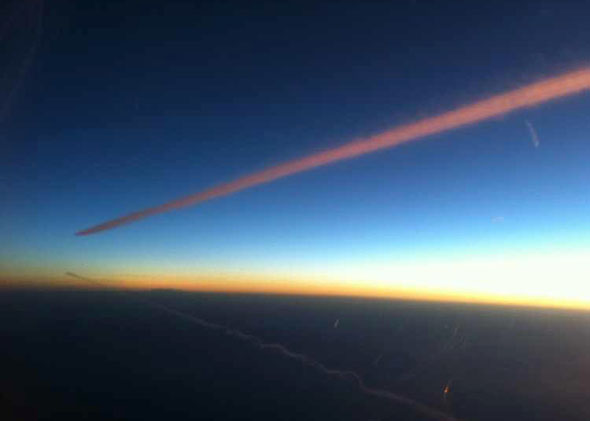An Ocean of Air
The atmosphere is as substantive and wild as water.

Photo courtesy Mark Vanhoenacker
All week Mark Vanhoenacker will be sharing stories about piloting and planes excerpted from his book Skyfaring: A Journey With a Pilot. Out now from Knopf.
Air, in general parlance, is almost always an absence. A synonym for nothing. “It came out of the blue.” “It vanished into thin air.” Air is so devoid of imaginative weight that Galileo’s discovery of its actual weight shocked the scientific world. Imagine a cube of ordinary sea-level air, a yard on each side. It weighs about 2 pounds—about the same as a liter or quart of water. Or, the next time you are lying on a picnic blanket and you gaze up at the contrail of a passing plane, consider that a round column of air only half an inch across—about the diameter of your iris—running from the Earth’s surface all the way up to outer space, contains about 2.5 pounds of air. Or that a typical picnic blanket—6 feet by 9 feet, say—has about 50 tons of air resting upon it.
To me, the truth that air is as substantive as concrete remains as counterintuitive as any of science’s most inscrutable revelations about particles that exist in two places at once, or the unseen dark matter we are told comprises most of the universe. Little in daily life suggests that the air weighs down upon me as matter‑of‑factly as water rests on the bottom of an aquarium; that each day I awake and stand up and walk through insensible thickness.
The writer David Foster Wallace once related a tale of an old fish who asks a pair of young fish how the water is that day. The young fish are mystified; they do not know what water is.
Flight reminds us to ask: How is the air? The air is so marvelously alive that when I land from a flight and later take a walk under an open sky, I know I have left all the most physically dramatic activities of the natural world behind me, above me. And when we fly, we confront many of our earthbound assumptions that would otherwise remain as unchallenged as the apparent emptiness of the air itself. There is a reason airliners have devices called air data computers. A pilot must learn to speak of at least four kinds of speed, and several more of temperature, distance, and altitude.
It is an irony of flight—particularly of modern high-altitude, high-speed flight—that while an airliner inhabits the air even more fully than a boat inhabits the water, it quickly leaves most of that air behind. It’s true that the atmosphere is a desperately thin band of air around the Earth—thinner, comparatively, than the skin of an apple, as warnings about air pollution often remind us. But the greater shock is how quickly the atmosphere attenuates, even within this thin skin. Air is not distributed evenly throughout the atmosphere. Unlike water, which is barely compressible, the air accumulates at the bottom of its ocean; it piles up under its own considerable weight.
If I picture the Earth from space again, I might remember that it is about 8,000 miles in diameter. To climb 3.5 miles—about halfway up to a typical airliner’s cruising altitude—is to have barely left the Earth at all. Yet at this altitude, about half the Earth’s air is already below. You could still breathe here, though, albeit with difficulty—most people climb Mount Kilimanjaro, which is nearly 4 miles high, without using oxygen tanks. Higher up still, at a typical cruising altitude of 7 miles, about four-fifths of the world’s air is already below the airplane. Airliners do not yet enter space. But in terms of escaping the atmosphere that sustains everything we know, they get us most of the way. Such a rapid fading of the atmosphere is related to one of aviation’s more curious revelations about the air: that altitude itself is a fluid concept.
Even before a plane takes off, there is nothing simple about altitude. The Earth is not a perfect sphere. Its true, misshapen character must be approximated for purposes of navigation, and whichever magisterially monikered model is used—World Geodetic System 1984, for example—must be carefully noted on our charts. Altitudes may be referenced to mean sea level, but this, too, is only an approximation; sea level depends on the tide, on the season, on which side of the Panama Canal you are on.
As creatures of the air, it’s fitting that planes calculate their altitude by measuring air pressure. The air lies most heavily on places that are lowest, the places that have the most air piled above them. A barometric altimeter equates high air pressure—lots of air weighing down—with low altitude. The air, we’re told, is as weighty and real as books stacked on my outstretched hand. On the ground the altimeter feels the weight, we might say, of 10 books, and converts this reading to an altitude. Then, as a plane climbs, there is less air above it, and fewer books. The altimeter senses less air weight, less air pressure, and reports a higher altitude.
But there are problems with this simple equation. Imagine you are on top of a mountain in autumn. An altimeter registers the weight of air pressing down upon it and accurately equates this with an altitude of 10,000 feet. But on a winter’s day, in the same situation, the cold will cause the air to become denser and sink. More of the atmosphere’s air will pile up below the mountain, and less will be above the altimeter to weigh down on it. This decreases the pressure around the altimeter. All the altimeter knows is that there is less air weight, and so it reports an altitude higher than its true altitude.
So even in sophisticated airliners, pilots must manually apply cold-weather corrections to the heights of mountains. We might say that we’d normally wish to pass above a certain 10,000-foot mountain at 12,000 feet; but it is so cold out, we decide to treat the mountain as if it were 12,000 feet, and overfly it at 14,000 feet instead. This gives the all-but-inescapable impression that granite grows in winter—that when cold falls over the land, mountains rise farther into the sky, until spring comes and they descend.
* * *
When I come into New York City, I sometimes walk through the New Jersey Transit concourse, to exit at 31st Street, where, occasionally, my eye is caught by a fragment of Walt Whitman on the station’s tiled wall: “This is the common air that bathes the globe.” (In another poem Whitman extolled the “fierce-throated beauty” of locomotives, “launch’d o’er the prairies wide, across the lakes, / To the free skies unpent and glad and strong”—reason to speculate on what he would have made of airliners.)
The substance of flight is that air appears to have none at all. But it’s worthwhile, just occasionally, to try to consider Whitman’s commonwealth of air as directly as we can. You might think of a journey by air first as a length. Imagine the line of your flight, not along the Earth as we normally envisage it, but above it in the sky, slicing through our common air. The path cuts a narrow, staggeringly long portion of the atmosphere, a nearly linear volume that you travel through, and breathe from, after the engines compress it into something thick enough to sustain you.
You change that common air. You leave footprints in it, in the form of the contrails, along of course with the other byproducts of combustion and, indeed, of your own respiration. The engines awaken eddies no less real than the ripples on a lake—occasionally seen directly in the rotors of the contrails, streaming like ballet ribbons—while the wings raise unknowable architectures of wind and leave them to drift through the heavens. When pilots encounter a bump we think is the wake of another, unseen aircraft, we may gesture out at the invisible air-realm and say: “Someone’s been here before.” (That someone may be us; when practicing turns in a small plane, you know you’re rounding out a neat, more or less horizontal circle through the sky when you have the satisfaction of crossing the jolt of your own wake.) And the air you exhale on the plane, the plane exhales, too. Your breath trails across the world.
Alternatively you might imagine the air as a sphere. When I think of the sky this way, I remember pictures of the Earth taken from space. Imagine the glowing rim of blue, the air, as a kind of second sphere that surrounds its interior, its rock-and-water twin. The atmosphere, something we might move through; something we can see. Something more than nothing. This vision of the air-sphere also suggests the truth that our air is shared, communal (the transcending speaker of Whitman’s “Song of Myself,” perhaps), that it’s exchanged and balanced by the breaths of animals and plants, of volcanoes and the seas. This spherical conception of the air is a reminder that we live on the world, not in it. What we live in is the atmosphere: the glowing air-planet that envelops the rock and water.
Or you might think of air not as length or sphere but as depth. Here, again, there is truth and comfort in the natural analogy with water. Evangelista Torricelli, the inventor of the barometer, framed this in a 1644 letter: “Noi viviamo sommersi nel fondo d’un pelago d’aria.” We live submerged at the bottom of an ocean of air. Ralph Waldo Emerson, too, would speak of our enveloping air-sea, a few centuries later, in “this ocean of air above ... this tent of dropping clouds.” There’s a particular kind of airport weather report known as a surface actual: the latest dispatch from the surface of the Earth, from the bottom of the air-ocean.
When you put your mouth over an empty plastic water bottle and inhale, the bottle collapses. Not, as we may think, because your inhalation pulls the sides of the bottle in, but because you remove the air that held the bottle’s shape against the crush of the atmosphere. The two sumo wrestlers of the atmosphere press equally on the inside and the outside of the bottle, and the bottle holds its shape, immobilized; when the inner one is removed, the bottle falls in on itself. The bottle of water I open in an airplane at high altitude crinkles and compresses when I descend, as it would if I plunged it deep into the ocean. The typical altitude of an airliner is about the depth of the Challenger Deep, the deepest known point of the oceans.
Under our aerial sea, the heft of the sky presses down on us, as water does on deep-sea creatures, or on us when we dive too deeply. We walk along the bottom of our air-ocean, as unaware of our water as David Foster Wallace’s young fish. Occasionally we board a plane and swim-fly upward.
Also in Skyfaring:
Excerpted from Skyfaring: A Journey With a Pilot by Mark Vanhoenacker. Copyright © 2015 by Mark Vanhoenacker. Excerpted by permission of Alfred A. Knopf, a division of Random House LLC. All rights reserved. No part of this excerpt may be reproduced or reprinted without permission in writing from the publisher.
Listen to Julia Turner talk to Mark Vanhoenacker on Slate’s Working podcast:
